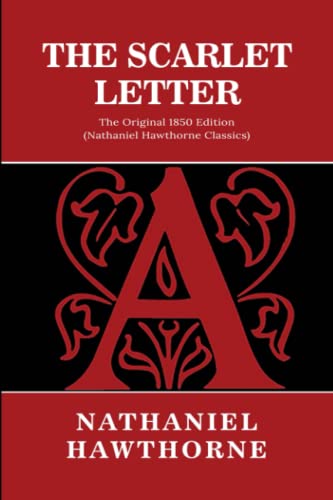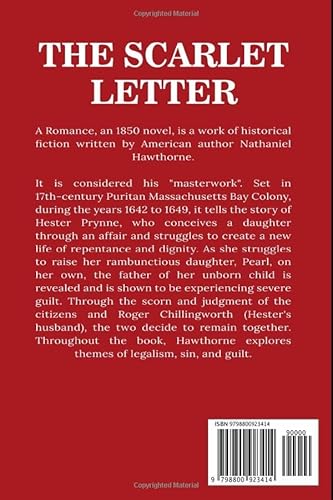Oh boy, folks! Today, I’m reviewing The Scarlet Letter, a book that takes us on a rollercoaster through 17th-century Puritan New England. Think of it as the ultimate reality show, minus the cameras and with a lot more judgmental stares. This classic by Nathaniel Hawthorne is like that old sweater your grandma knitted—full of intricate patterns (read: symbolism) and a bit itchy but ultimately warm and comforting. I’ll be diving into the plot, characters, themes, and even the historical backdrop, so grab your popcorn and let’s get this literary party started!
Laughing Along with ‘The Scarlet Letter’
In a nutshell
The Scarlet Letter by Nathaniel Hawthorne is a historical fiction classic. The book is set in a strict Puritan society in the 1600s. It tells the story of Hester Prynne, who has an affair and bears an illegitimate child named Pearl. Forced to wear a scarlet ‘A’ on her dress, Hester faces public shame and personal struggle.
Themes of sin, guilt, and redemption run deep in this book. Hester’s resilience and the society’s rigid moral code create a fascinating backdrop. Hawthorne’s writing dives into human nature and societal judgement with rich symbolism. If you enjoy tales of moral complexity and emotional depth, this book is a must-read.
The Scarlet Letter: A Gripping Tale of Sin and Redemption
Alright folks, grab a cup of coffee and let’s talk about the plot and storyline of ‘The Scarlet Letter’ by Nathaniel Hawthorne. I know, I know – some of you might think, ‘Oh no, not another boring classic!’ But hold your horses, this one’s a rollercoaster ride of emotions.
The story kicks off in 17th-century Puritan Massachusetts. It’s like being in a real-life episode of ‘Desperate Housewives’ but with more bonnets and fewer wine nights. Hester Prynne, our gutsy heroine, is caught in adultery and given the infamous scarlet ‘A’ to wear on her chest. It’s like a giant, red tweet saying ‘Yes, I messed up.’
Hester’s lover is the town’s minister, Arthur Dimmesdale, who’s sweating bullets trying to keep his involvement a secret. Meanwhile, her estranged husband, Roger Chillingworth (seriously, couldn’t they give the guy a friendlier name?), decides to play Sherlock Holmes and starts a twisted game of cat and mouse with Dimmesdale. The plot thickens as we see Hester raising her daughter Pearl in this judgmental society. Pearl, by the way, is like a mini sparkplug of mystery and charm.
The storyline dives deep into themes of guilt, revenge, and redemption. Hawthorne’s writing is richly detailed but never goes overboard, making you feel like you’re living the drama right along with the characters. However, some parts can feel a bit slow, like churning butter – but hold tight, the payoff is worth it.
So, if you’re a fan of tension-filled plots that tackle heavy themes, ‘The Scarlet Letter’ will keep you hooked. But head’s up; the Puritan-era language can be a bit of a brain workout at times.
Next up, let’s chat about the fascinating character development in ‘The Scarlet Letter’. Spoiler: They’re more complex than a plate of spaghetti!
Character Development in ‘The Scarlet Letter’
‘The Scarlet Letter’ by Nathaniel Hawthorne has some wild character developments. Seriously, these characters go through more changes than a chameleon at a disco. And trust me, you won’t need a PhD to see it. The main characters in this book are as deep as the Mariana Trench.
Take Hester Prynne, for example. At the start, she’s wearing that big ol’ ‘A’ on her chest and feeling the shame. But by the end, she’s fire. A total queen. Hester grows stronger with each passing page. Her journey from public humiliation to a respected member of society is like watching a caterpillar turn into a badass butterfly.
Then there’s Reverend Arthur Dimmesdale. This guy is like a roller coaster of emotions. One second he’s up, the next he’s down. He’s guilt-ridden and basically a walking stress ball. His journey is tragic and intense, showing the dark side of keeping secrets. Dimmesdale’s internal struggle is so real, you almost want to hand him a stress toy.
Let’s not forget Roger Chillingworth. This dude starts out as Hester’s long-lost husband, but he morphs into this vengeful, obsessed guy. It’s like watching a decent dude turn into Darth Vader.
Even little Pearl, Hester’s daughter, goes through her own transformations. She starts off as this mischievous kid but grows into a thoughtful young girl. Pearl’s curiosity and spirit add layers to the story. By the end, you can’t help but love her spunk.
The characters in ‘The Scarlet Letter’ are complex and unforgettable. They evolve like crazy, making the book a compelling read from start to finish.
Now, let’s turn the page and unravel the rich symbolism and themes that make this book a classic.
Symbolism and Themes in ‘The Scarlet Letter’
Ah, the magic of symbols in ‘The Scarlet Letter’! This book is like a symbolic buffet. You get Hester Prynne with her infamous scarlet letter ‘A’. That ‘A’ is the VIP of symbols. At first, it stands for ‘Adulterer’. But as the story unfolds, it shapeshifts into ‘Able’ and eventually becomes a powerful symbol of identity.
There’s also Pearl. She isn’t just a cute kid. She’s a living, breathing symbol of her parents’ sin and love. Every time she shows up, it’s like Hawthorne saying, ‘Look, more symbolism!’ And let’s not forget the scaffold scenes. You get the major tea spilled in these spots! It’s where confession, shame, and redemption happen, making it the ultimate drama stage in this Puritan soap opera.
But wait, there’s more! The forest versus the town. The woods aren’t just a bunch of trees. They symbolize freedom and natural law, a place where societal rules don’t apply. While the town is all about order and punishment.
Oh, and the themes! You’ve got sin, guilt, and redemption as the holy trinity. Then add hypocrisy and judgment to the mix, and you’ve got yourself some hefty, thought-provoking material.
Hawthorne isn’t just writing a book; he’s painting a complex picture of human nature and societal norms. This depth makes the book a classic that still resonates today. Next up, let’s travel back in time and delve into the historical context of ‘The Scarlet Letter’. Buckle up; it’s going to be a bumpy ride!
Historical Context in ‘The Scarlet Letter’
‘The Scarlet Letter’ by Nathaniel Hawthorne? Oh boy, this book takes you on a roller coaster back to the 17th century. Think Puritan New England – not exactly your cozy vacation spot, unless you enjoy strict religious rules and zero tolerance for shenanigans.
One day, I joked to my friend that living in that time would have meant no binge-watching our favorite shows on Netflix. Instead, they had public shaming, stocks, and really itchy clothes made of wool. Hester Prynne, our protagonist, is a woman ahead of her time, stuck in a society that isn’t quite ready for her independent spirit.
Hester’s story springs from a historical moment when the Puritans sought to create a ‘city upon a hill.’ They emphasized hard work, religious devotion, and, well, pretty much frowned upon anything fun. Her punishment for having an affair – wearing the letter ‘A’ for adulteress – wasn’t just about the scarlet letter itself. It was about a community trying to maintain control and order, not to mention a hefty dose of hypocrisy.
Hawthorne himself had some family baggage. His ancestors were involved in the Salem witch trials, which might explain why he was a bit obsessed with themes of guilt and sin. Writing ‘The Scarlet Letter’ was his way of grappling with that dark history.
So, do I recommend ‘The Scarlet Letter’? Absolutely, yes! It’s not just a book; it’s a time machine, a reality check, and a fascinating study of human nature. Plus, you’ll get to sound really smart at dinner parties.
Conclusion
Well, folks, that’s my take on ‘The Scarlet Letter.’ It’s got emotional depth, complex themes, and some wild character development. Hester, Dimmesdale, Chillingworth, and Pearl all bring something interesting to the table. The symbolism, like the scarlet letter ‘A’ and the forest, will keep you thinking. And the historical context? It makes you glad you weren’t a Puritan. Sure, sometimes Hawthorne gets a bit long-winded, but hey, nobody’s perfect. All in all, it’s a classic worth your time. So, happy reading, and don’t blame me if you start seeing scarlet letters everywhere!



